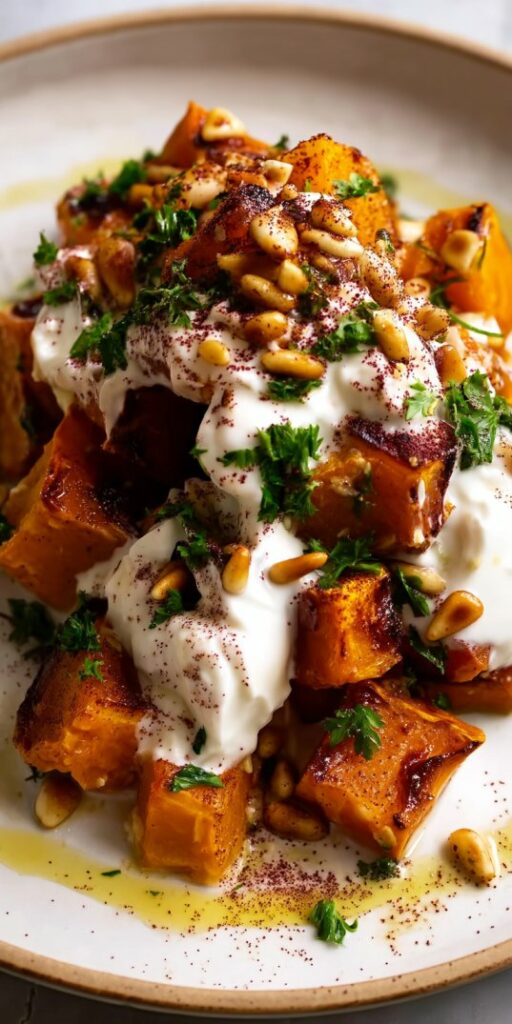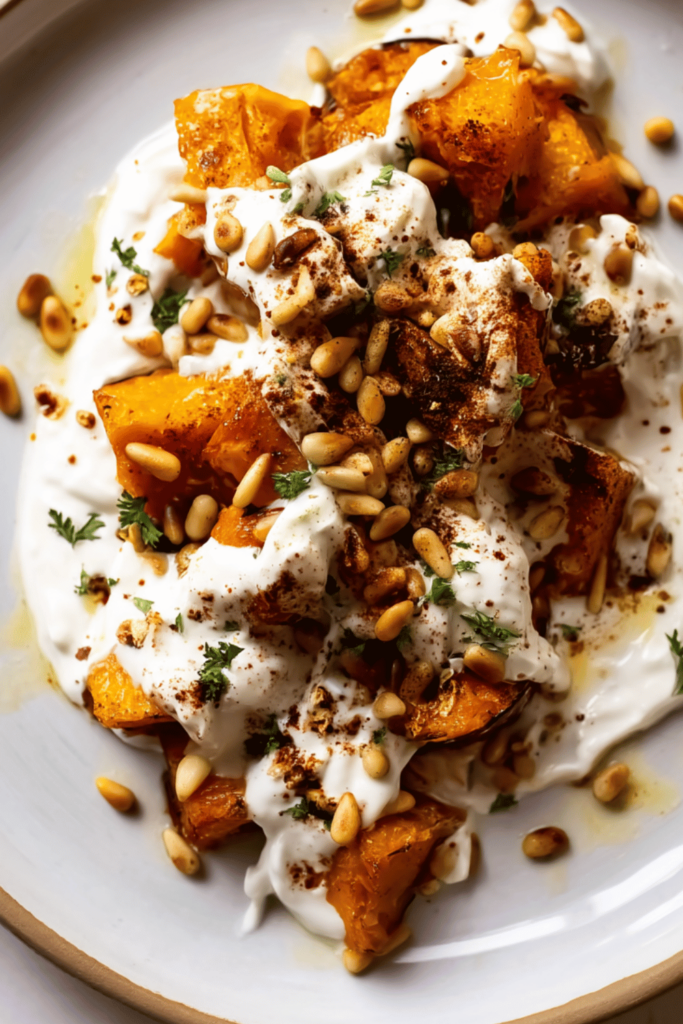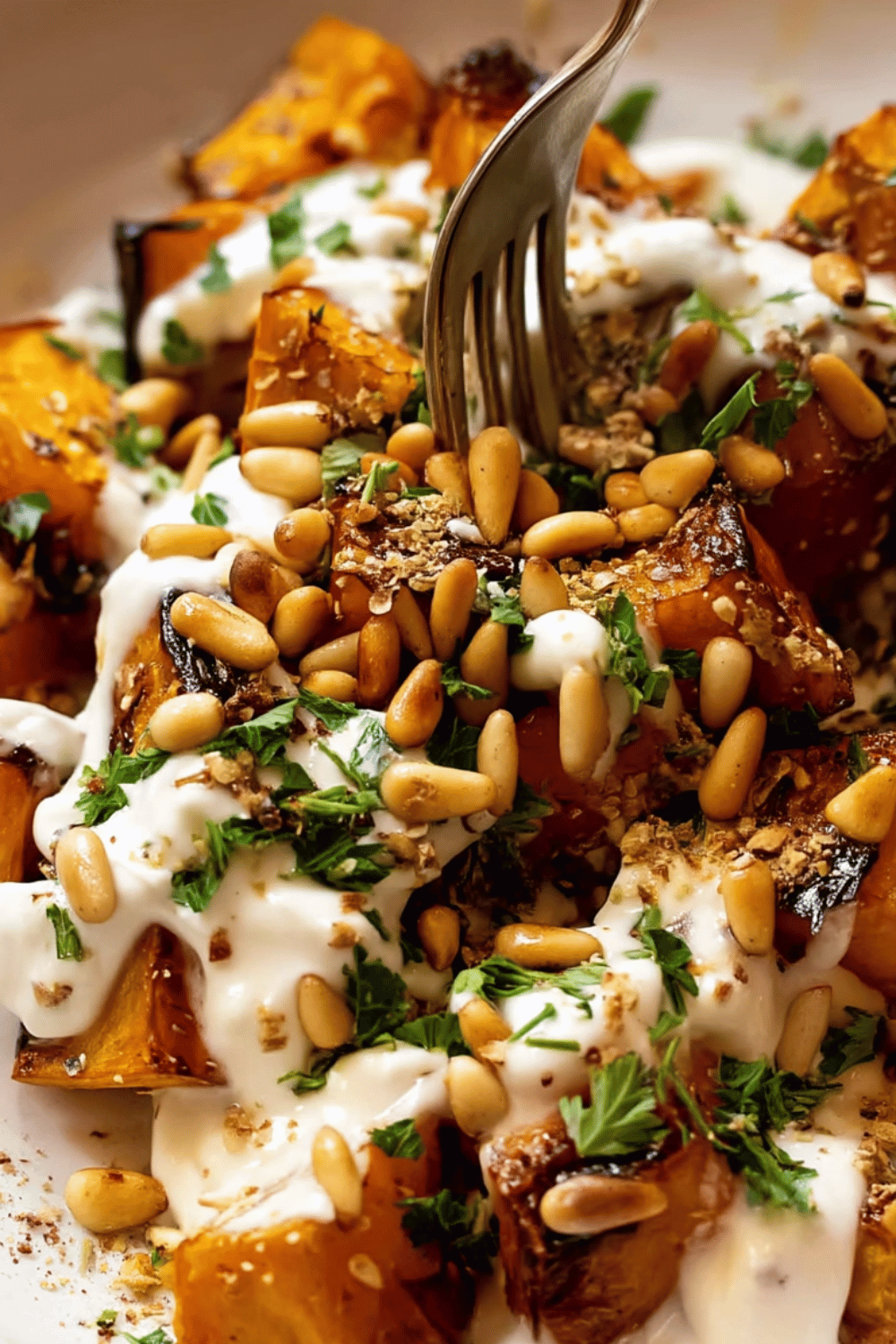This Middle Eastern-Inspired Roasted Pumpkin Side brings together caramelized, golden pumpkin with a creamy lemon yogurt sauce.

The contrast is bright, savory, and deeply satisfying.
Finished with toasted nuts, sumac, and herbs, this side dish is a stunning addition to any spread. It’s perfect for festive tables or everyday dinners alike.
Star Ingredients for This Middle Eastern-Inspired Roasted Pumpkin Side
Pumpkin – Roasted to tender, golden perfection, pumpkin delivers a sweet, nutty flavor and hearty texture that’s both comforting and versatile.
Greek Yogurt – Creamy and tangy, it forms the base of a luscious sauce that balances the sweetness of the pumpkin.
Lemon Juice – Adds brightness and a subtle acidity to lift the yogurt sauce.
Pine Nuts – Toasted to bring out their buttery richness, adding crunch and warmth to each bite.
Sumac – This deep red spice introduces a citrusy zing that complements both the yogurt and pumpkin.
Fresh Coriander – Offers a burst of herbal freshness, rounding out the dish with vibrant color and aroma.
How to Make This Middle Eastern-Inspired Roasted Pumpkin Side
The pumpkin is cubed and roasted until golden and just tender, creating caramelized edges that contrast beautifully with the creamy lemon yogurt sauce. The final drizzle of olive oil and scattering of sumac, pine nuts, and herbs elevates the visual appeal and flavor complexity.
Recipe Tips
Roasted pumpkin shines even brighter when made with skin-on varieties like Kent or Queensland Blue for added nuttiness.
To avoid a garlic-heavy aftertaste, go easy on the raw garlic in the sauce or opt for garlic powder.
Readers also love using sweet potatoes or adding elements like pomegranate seeds, red onion, or lentils to turn this into a fuller meal.
Toasting the nuts just before serving preserves their crunch and aroma.

How to Store Leftovers of Your Middle Eastern-Inspired Roasted Pumpkin Side
Keep the roasted pumpkin and yogurt sauce stored separately in airtight containers in the fridge for up to 5 days.
Reheat the pumpkin gently to maintain texture, and only combine with the sauce and garnishes just before serving to preserve freshness and presentation.
Frequently Asked Questions
Can I use sweet potato or butternut squash instead of pumpkin?
Yes, sweet potato and butternut squash both roast beautifully and pair well with the tangy yogurt sauce.
Do I have to peel the pumpkin?
If using varieties like Kent or Queensland Blue, the skin can be left on for extra flavor and texture.
What can I use instead of pine nuts?
Almonds, walnuts, or even toasted pumpkin seeds work well and offer a delicious crunch at a lower cost.
Can I make this dish ahead of time?
Absolutely. Roast the pumpkin in advance and refrigerate it. Assemble with the sauce and toppings just before serving for best results.


Middle Eastern-Inspired Roasted Pumpkin Side
Ingredients
Roasted Pumpkin:
- 2 tablespoons extra virgin olive oil
- 1.2 kg 2.4 lb pumpkin (or sweet potato or butternut squash), skin on, seeds-in weight
- ½ teaspoon salt
- ½ teaspoon black pepper
- 1 garlic clove finely minced
Lemon Yogurt Sauce:
- ¾ cup Greek yogurt or any plain unsweetened yogurt
- 1 tablespoon fresh lemon juice
- ¼ teaspoon black pepper
- ¼ teaspoon salt
- 1 tablespoon extra virgin olive oil
- ½ small garlic clove finely minced
Garnishes and Toppings:
- 2 tablespoons fresh coriander or cilantro roughly chopped (parsley also suitable)
- 2 tablespoons pine nuts or substitute with almonds or other nuts
- ⅛ teaspoon sumac or an alternative like paprika or cinnamon
Instructions
- Preheat the oven to 220°C (430°F) or 200°C (fan-forced). Line a baking tray with parchment paper. Peel, deseed, and chop the pumpkin into cubes approximately 3 cm (1.2 inches) in size. Expect to yield around 1 kg of usable pumpkin.
- In a mixing bowl, combine the cubed pumpkin with olive oil, minced garlic, salt, and pepper. Use a rubber spatula to coat the pieces evenly. Distribute the seasoned pumpkin across the lined tray in a single layer.
- Roast in the oven for 20 minutes, then use tongs or a spatula to turn the pieces. Continue roasting for an additional 7–10 minutes, until the pumpkin is golden and tender yet still holds its shape.
- In a small bowl, mix the yogurt, lemon juice, olive oil, salt, pepper, and minced garlic. Let the sauce rest for at least 10 minutes to allow the flavors to meld.
- Heat a dry skillet over medium-high heat. Toast the pine nuts by stirring frequently until they emit a nutty aroma and are lightly browned on both sides. Remove from heat immediately to prevent burning.
- To assemble, arrange the roasted pumpkin in a mound on a serving plate. Drizzle with the lemon yogurt sauce, add a touch more olive oil if desired, and scatter the toasted pine nuts, sumac, and chopped herbs on top.
- This dish shines when served warm or hot but is equally enjoyable at room temperature on a warm day. If serving later, cool the roasted pumpkin completely before garnishing just prior to serving.
